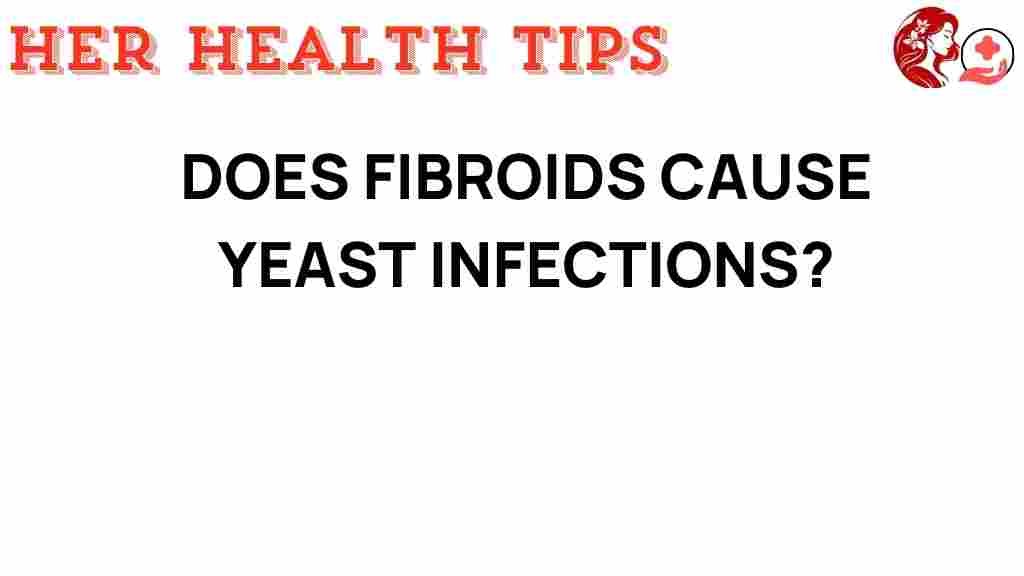Unraveling the Mystery: Do Fibroids Cause Yeast Infections?
When it comes to women’s health, understanding the relationship between various reproductive health issues is crucial. One common question that arises is whether fibroids can cause yeast infections. Fibroids are non-cancerous growths in the uterus that can lead to various symptoms, while yeast infections are caused by an overgrowth of yeast, often resulting in discomfort and irritation. This article aims to explore the connection between fibroids and yeast infections, discussing symptoms, treatment options, misconceptions, and the latest research.
Understanding Fibroids
Fibroids, also known as uterine leiomyomas, are abnormal growths in the uterus that can vary in size, shape, and location. They can be classified into several types:
- Intramural fibroids: These grow within the muscular wall of the uterus.
- Subserosal fibroids: These develop on the outer wall of the uterus.
- Submucosal fibroids: These form just beneath the inner lining of the uterus.
Many women experience symptoms such as heavy menstrual bleeding, pelvic pain, and pressure on the bladder or rectum due to fibroids. However, some women may be asymptomatic. The size of the fibroids can also affect the severity of symptoms.
What Are Yeast Infections?
Yeast infections, primarily caused by the fungus Candida, are a common issue among women. They occur when there is an imbalance in the natural flora of the vagina, leading to an overgrowth of yeast. Symptoms typically include:
- Itching and irritation in the vaginal area
- Thick, white vaginal discharge
- Burning sensation during urination or intercourse
- Redness and swelling of the vulva
While yeast infections are not typically considered a serious health risk, they can cause significant discomfort and distress.
Fibroids and Yeast Infections: The Connection
The question remains: do fibroids cause yeast infections? To address this, we need to consider several factors, including hormones, symptoms, and the overall reproductive health of women.
Hormonal Influences
The development and growth of fibroids are often influenced by hormones, particularly estrogen and progesterone. These hormones regulate the menstrual cycle and can affect the vaginal flora. Some research suggests that hormonal imbalances may lead to an environment more conducive to yeast infections. Therefore, women with fibroids might experience hormonal fluctuations that could predispose them to yeast infections.
Symptoms Overlap
Both fibroids and yeast infections can lead to similar symptoms, such as pelvic pain and discomfort. This overlap can sometimes lead to misconceptions about their relationship. For instance, a woman experiencing pelvic pain from fibroids may mistakenly attribute her symptoms to a yeast infection or vice versa.
Research Insights
Current research on the connection between fibroids and yeast infections is limited. However, some studies have explored how hormonal changes impact the vaginal microbiome. As women with fibroids often deal with hormonal fluctuations due to the growths, it is possible that these changes could impact their susceptibility to yeast infections.
Researchers are continuing to investigate the complex interactions between hormones, fibroids, and vaginal health. One study published in the National Institutes of Health database suggests that the hormonal environment created by fibroids may influence the vaginal flora, potentially leading to an increased risk of yeast infections.
Treatment Options
If you are experiencing symptoms related to fibroids or yeast infections, it is essential to consult with a healthcare provider. Treatment options may vary based on the severity of symptoms and the specific diagnosis:
- For fibroids:
- Medications to regulate hormones and reduce symptoms
- Uterine artery embolization to shrink fibroids
- Surgical options, such as myomectomy or hysterectomy, for more severe cases
- For yeast infections:
- Over-the-counter antifungal treatments
- Prescription antifungal medications for more severe cases
- Probiotics to restore healthy vaginal flora
It’s crucial to receive a proper diagnosis to ensure that you’re receiving the appropriate treatment for your condition.
Misconceptions About Fibroids and Yeast Infections
There are several misconceptions surrounding fibroids and yeast infections:
- Misconception 1: Fibroids directly cause yeast infections.
- Misconception 2: All women with fibroids will experience yeast infections.
- Misconception 3: Yeast infections can lead to the development of fibroids.
It’s essential to debunk these myths to enhance understanding of women’s health. While hormonal changes associated with fibroids may affect vaginal health, they do not directly cause yeast infections.
Troubleshooting Tips for Managing Symptoms
If you are dealing with both fibroids and yeast infections, here are some tips to help manage your symptoms:
- Maintain a Healthy Diet: A balanced diet rich in probiotics (like yogurt) can support vaginal health.
- Stay Hydrated: Drinking plenty of water can help your body maintain a healthy balance.
- Manage Stress: Stress can affect hormonal balance; consider techniques like yoga or meditation.
- Regular Check-ups: Keep up with gynecological appointments to monitor your reproductive health.
Conclusion
In conclusion, while there is no direct evidence that fibroids cause yeast infections, hormonal imbalances associated with fibroids may contribute to an increased risk of developing them. Understanding the relationship between these two conditions is essential for women’s health and reproductive health. If you experience symptoms related to either condition, it is vital to consult with a healthcare provider for accurate diagnosis and treatment.
By dispelling misconceptions and staying informed through research, women can take proactive steps towards managing their health. Always remember that your health is a priority, and seeking professional advice is key to navigating the complexities of fibroids, yeast infections, and overall reproductive wellness.
For more information on women’s health topics, visit our health resource page.
This article is in the category Reproductive and created by HerHealthTips Team
